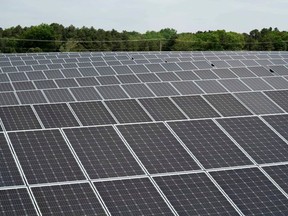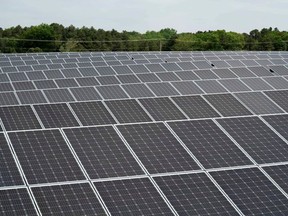Breadcrumb Links
Opinion columnist
It is technology that got us into this global climate crisis, and it is technology that will get us out of it.
Article Author:
Gwynne Dyer • Special to Postmedia News
Published on June 8, 2024 • Last updated 7 hours ago • 3 min read
To save this article, register for free here, or sign in if you have an account.
 Solar, wind and nuclear power are already good alternatives to fossil fuels, but now a promising new candidate is emerging. (Reuters file photo)
Solar, wind and nuclear power are already good alternatives to fossil fuels, but now a promising new candidate is emerging. (Reuters file photo)
Article Contents
It was technology that got us into this global climate crisis, and it is technology that will get us out of it: technology that allows us to continue living in a high-energy civilization without burning fossil fuels, and technology that keeps the heat from overwhelming us while we work toward that goal.
Solar, wind, and nuclear power are already good alternatives to fossil fuels, but now a promising new candidate is emerging: Geothermal power was once limited to countries with hot volcanic rocks near the surface, but now startups are going deep underground and using a different kind of hydraulic fracturing.
Ad 2
This advertisement has not loaded yet, but article continues below.
This content is available to subscribers only
Subscribe now to read the latest news from your city and across Canada.
Exclusive stories from Ryan Pyette, Dale Carruthers, Jane Sims, Norman De Bono and more. Plus, we send you the Noon News Roundup newsletter during the week and the LFP Weekender newsletter on weekends. One account gives you unlimited online access to the London Free Press and 15 other news sites. The London Free Press ePaper is a digital version of the print edition that you can read, share and comment on on any device. Daily puzzles, including the New York Times crossword. Support local journalism.
Subscribe to unlock more articles
Subscribe now to read the latest news from your city and across Canada.
Exclusive stories from Ryan Pyette, Dale Carruthers, Jane Sims, Norman De Bono and more. Plus, we send you the Noon News Roundup newsletter during the week and the LFP Weekender newsletter on weekends. One account gives you unlimited online access to the London Free Press and 15 other news sites. The London Free Press ePaper is a digital version of the print edition that you can read, share and comment on on any device. Daily puzzles, including the New York Times crossword. Support local journalism.
Register/Sign in to view more articles
To continue reading, please create an account or sign in.
Access articles from across Canada with one account. Share your thoughts in the comments and join the conversation. Enjoy additional articles every month. Receive email updates from your favourite authors.
Sign in or create an account
or
Article Contents
Four kilometers below the surface lies hot, dry rock (200-400°C), which underlies half of the Earth's land mass. High-pressure water is used to break up the rock, turning the water into super-hot steam. This steam spins turbine blades to produce electricity, which is then cooled and pumped back up to the surface.
The technology has the potential to be larger than solar or wind power because it can produce electricity day or night, in all weather conditions: The first megawatt-scale pilot plant opened in Nevada last year.
Beyond energy, the top priority is a global solution to the accelerating loss of biodiversity. This can only be achieved by returning to natural conditions at least half of the land that humans have devoted to agriculture, and miraculously, such a solution has emerged.
This is called precision fermentation, and if you put the right microbes in a bioreactor and feed them water, carbon dioxide, hydrogen and sunlight, they'll double in mass every three hours. The resulting soup can be drained and dried, yielding 65 percent edible protein, fat and carbohydrates. The biggest harvest here is for animal feed.
Ad 3
This advertisement has not loaded yet, but article continues below.
Article Contents
Half the world's farmland is used to feed livestock, so they could use this instead and rewild much of that land. The first factory is set to open near Helsinki this year.
But new technologies typically take 15 to 30 years to be deployed on a large scale, so there is little reason to think that these new technologies will be any different. We remain at great risk, given how quickly warming is occurring and that we will almost certainly pass tipping points and create feedbacks that will cause even faster warming.
That's why we'll need solar radiation management (SRM), which means reducing the amount of sunlight that reaches the Earth's surface by 1-2 percent to keep warming to below 2 degrees Celsius, while we work to reduce emissions. It's not a solution, but it may be a necessary immediate measure to avoid political and economic chaos.
SRM involves reflecting sunlight back into space, and a leading candidate would be to use special aircraft to shoot sulfur dioxide high into the stratosphere.
Large volcanoes sometimes do just that, temporarily cooling the Earth's surface without harming living things. Some worry that this could lead to a larger ozone hole, but experts say that won't happen.
Ad 4
This advertisement has not loaded yet, but article continues below.
Article Contents
This was predicted 45 years ago by scientist James Lovelock, who realised that all of the Earth's natural systems are connected and named the whole system Gaia (now renamed Earth System Science at the University).
He knew that humanity would take too long to reduce emissions because that's human nature. He foresaw that humanity would have to intervene directly on the climate to save itself, and predicted that humanity would become the Earth's maintenance engineer.
I interviewed Jim one last time for my new book on climate change, eight months before he passes away in 2022 at age 103. “Are we there yet, Jim?” I asked him. “Yes,” he answered, but he wasn't despairing. We have the tools to get through this, if we use them wisely.
Gwynne Dyer is an independent journalist based in London, UK, and author of the new book Intervention Earth: Life-Saving Ideas from the World's Climate Engineers.
Article Contents
Share this article on social networks



